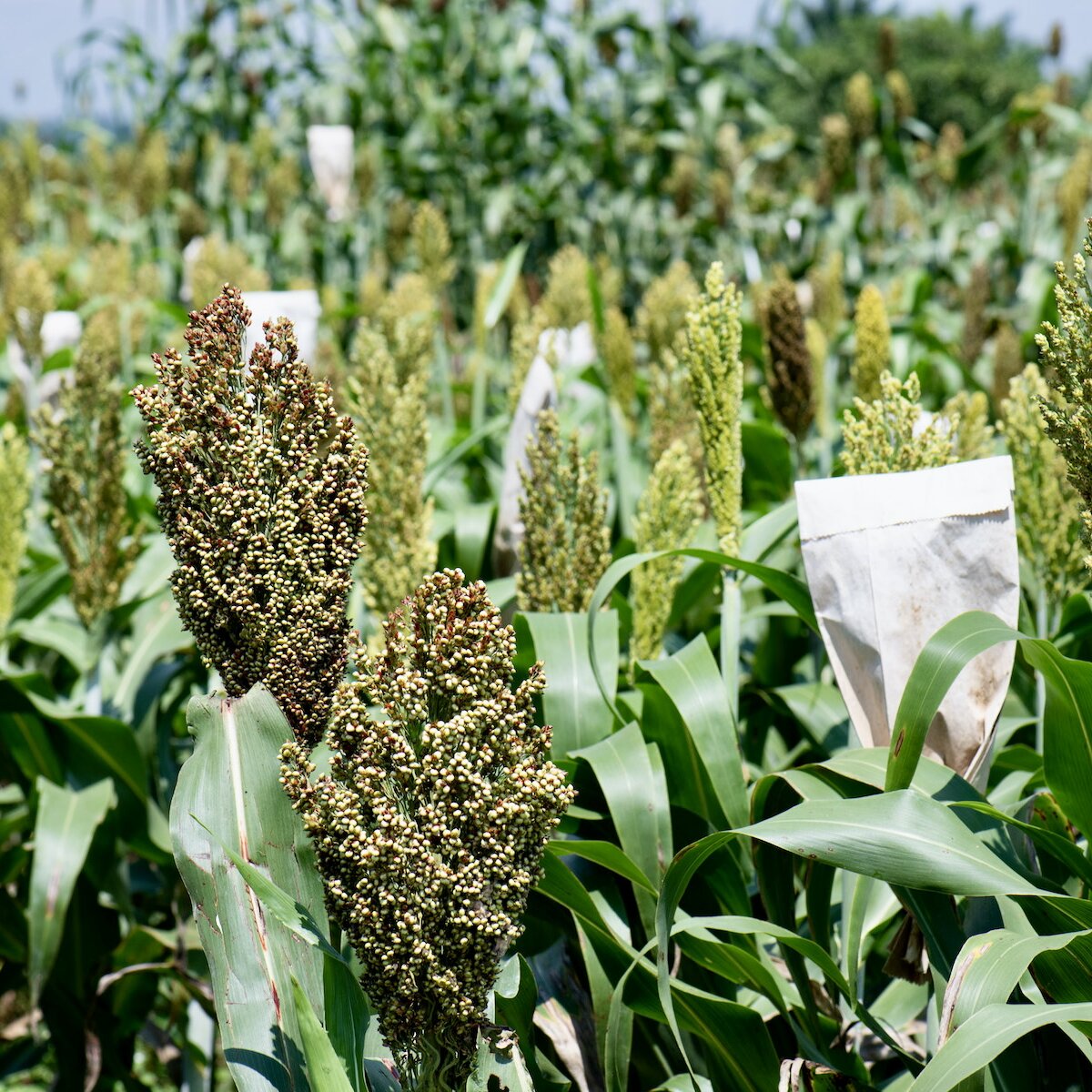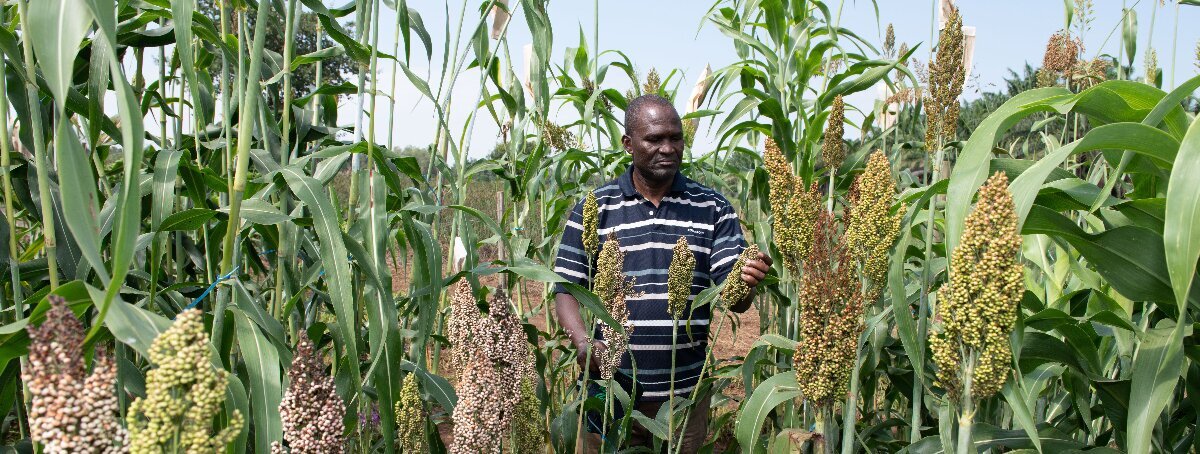Sorghum
Why sorghum?
Sorghum (Sorghum bicolor L. Moench) is the fifth most important cereal crop in the world in terms of production and harvested area. This drought-resistant cereal is a staple crop in Asia and Africa and is grown for both food and industrial purposes. It is grown on 45 million hectares worldwide, with 75% of the area concentrated in 10 countries: Sudan, India, Nigeria, Niger, USA, Mexico, Ethiopia, Burkina Faso, Mali and Chad.
What we achieved
Collecting
- 208 seed samples of four sorghum crop wild relatives (CWR) were collected from nine countries: Armenia, Azerbaijan, Ethiopia, Ghana, Kenya, Nigeria, Pakistan, Sudan and Uganda.
Pre-breeding and evaluation
- 333 sorghum lines (159 crosses with wild sorghum accessions from Mali, 165 pre-bred lines from Australia and three local varieties from Kenya) were multiplied and evaluated in on-station and on-farm trials in Kenya. Traits assessed included early maturity, grain yield, pest and disease resistance, panicle characteristics and tillering. In 2019, farmers selected 50 sorghum lines incorporating traits from sorghum wild relatives for further testing and evaluation and subsequently retained seed of 20 lines for future planting.
- 160 sorghum lines (151 pre-bred lines incorporating traits from sorghum wild relatives and nine local landraces and cultivars) were evaluated at multiple sites across Mali. Traits assessed included grain yield and quality, density of the panicle, maturity and retention of greenness in the stems at maturity. Farmers selected 18 lines for further testing in 2019 and 4 of these were retained for further farmer-participatory evaluation in 2020.
- More than 1,200 pre-bred lines were created in Australia through crosses between cultivated sorghum lines and nine sorghum wild relatives. These have been made available for use in further breeding efforts. The wild relative parents were also used to create a pan-genome map showing the genetic variation available within cultivated sorghum and its wild relatives.
- The whole set or strategic subsets have been shared with sorghum breeders in Ethiopia, Mali and Kenya.
- Genotype and phenotype data are available on the Germinate database.
- All 1,200 pre-bred lines has been tested in multilocation trials in Ethiopia and a relevant subset was tested in Kenya and Mali.
- Seed of most of the pre-bred lines is conserved in the Australian Grains Genebank and accessible to global users through the Standard Material Transfer Agreement (SMTA).
- Promising introgression progenies developed in Mali are held in the ICRISAT-Samanko breeders’ working-collection seed storage facilities and are available on request through the SMTA.

Project partners
Collecting
- Armenian Botanical Society, Yerevan, Armenia
- Genetic Resources Institute, Azerbaijan National Academy of Sciences, Baku, Azerbaijan
- Ethiopian Biodiversity Institute, Addis Ababa, Ethiopia
- Plant Genetic Resources Research Institute, Accra, Ghana
- Genetic Resources Research Institute, Kenya Agricultural and Livestock Research Organization, Nairobi, Kenya
- National Centre for Genetic Resources and Biotechnology, Ibadan, Nigeria
- Plant Genetic Resources Program, Bio-Resources Conservation Institute, Islamabad, Pakistan
- Agricultural Plant Genetic Resources Conservation and Research Centre, Wad Medani, Sudan
- Plant Genetic Resources Centre, National Agricultural Research Organisation, Entebbe, Uganda
Pre-breeding and evaluation
Lead Institute: Evaluation: Department of Agronomy and Environmental Sciences, Rongo University, Kenya, and Institut d’Economie Rurale, Mali; Pre-breeding: Queensland Alliance for Agriculture and Food Innovation, The University of Queensland, Australia
Partners:
- Aminyasa Youth Group, Kenya (evaluation)
- Ugenya Banana Farmer Group, Kenya (evaluation)
- Institut d’Economie Rurale, Bamako, Mali (evaluation)
- Union des Agriculteurs du Cercle de Tominian, Tominian, Mali (evaluation)
- Ethiopian Institute of Agricultural Research, Addis Ababa, Ethiopia (pre-breeding)
Sorghum key collections, materials and data
Sorghum collections
- The largest sorghum collection is conserved at the United States Department of Agriculture-Agricultural Research Services, Plant Genetic Resources Conservation Unit, Southern Regional Plant Introduction Station, University of Georgia, Griffin, Georgia.
- The Genesys PGR database also includes information about sorghum accessions in genebanks worldwide.
Pre-breeding materials
- The 1,200 pre-breeding lines produced in Australia are conserved in the Australian Grains Genebank, Horsham, Victoria, Australia.
- Promising introgression progenies developed in Mali are held in the ICRISAT-Samanko breeders’ working-collection seed storage facilities and are available on request through the SMTA.
Data
- All data from the CWR sorghum pre-breeding and evaluation projects are available in the Germinate sorghum database.
Sorghum stories
Crop Trust stories
- Building a toolbox of sorghum diversity. 17 February 2023
- Farmers in Mali go wild for sorghum. 30 January 2023
- Kenyan farmers welcome “exotic” sorghum. 23 January 2023
- Wild sorghum offers toolbox for climate-proofing future crops. 15 July 2021
- Stay-green sorghum to the rescue. 23 February 2021
Relevant publications
- Tao, Y., Mace, E., George-Jaeggli, B., Hunt, C., Cruickshank, A., Henzell, R., Jordan, D. 2018. Novel grain weight loci revealed in a cross between cultivated and wild sorghum. The Plant Genome 11(2): 170089. https://doi.org/10.3835/plantgenome2017.10.0089.
- Boateng, S.K., Aboagye, L.M., Egbadzor, K.F., Darko, R.K., Ameka, G.K., Ekpe, P., Kanton, R., Dogbe, W., Saaka-Buah, S. 2019. Collecting of crop wild relatives and minor crops in Ghana. Research in Agricultural & Veterinary Sciences 3(2): 89–95.
- Odeny, D.A., Niazi, A., Tesfaye, K., Lule, D., Wanyonyi, S., Kunguni, J.S. 2020. Genomic designing for climate smart finger millet. In: Kole, C. (ed.). Genomic designing for climate-smart cereal crops. Springer Nature. pp. 287–307.
- Mace, E.S., Cruickshank, A.W., Tao, Y., Hunt, C.H., Jordan, D.R. 2021. A global resource for exploring and exploiting genetic variation in sorghum crop wild relatives. Crop Science 61(1): 150–162.
- Muchira, N., Ngugi, K., Wamalwa, L.N., Avosa, M., Chepkorir, W., Manyasa, E., Nyamongo, D., Odeny, D.A. 2021. Genotypic variation in cultivated and wild sorghum genotypes in response to Striga hermonthica infestation. Frontiers in Plant Science 12: 671984. https://doi.org/10.3389/fpls.2021.671984.
- Müller, J.V., Cockel, C.P., Gianella, M., Guzzon, F. 2021. Treasuring crop wild relative diversity: analysis of success from the seed collecting phase of the ‘Adapting Agriculture to Climate Change’ project. Genetic Resources and Crop Evolution 68: 2749–2756.
- Ochieng, G., Ngugi, K., Wamalwa, L.N., Manyasa, E., Muchira, N., Nyamongo, D., Odeny, D.A. 2021. Novel sources of drought tolerance from landraces and wild sorghum relatives. Crop Science 61(1): 104–118.
- Tao, Y., Luo, H., Xu, J., Cruickshank, A., Zhao, X., Teng, F., Hathorn, A., Wu, X., Liu, Y., Shatte, T., Jordan, D., Jing, H., Mace, E. 2021. Extensive variation within the pan-genome of cultivated and wild sorghum. Nature Plants 7: 766–773.

